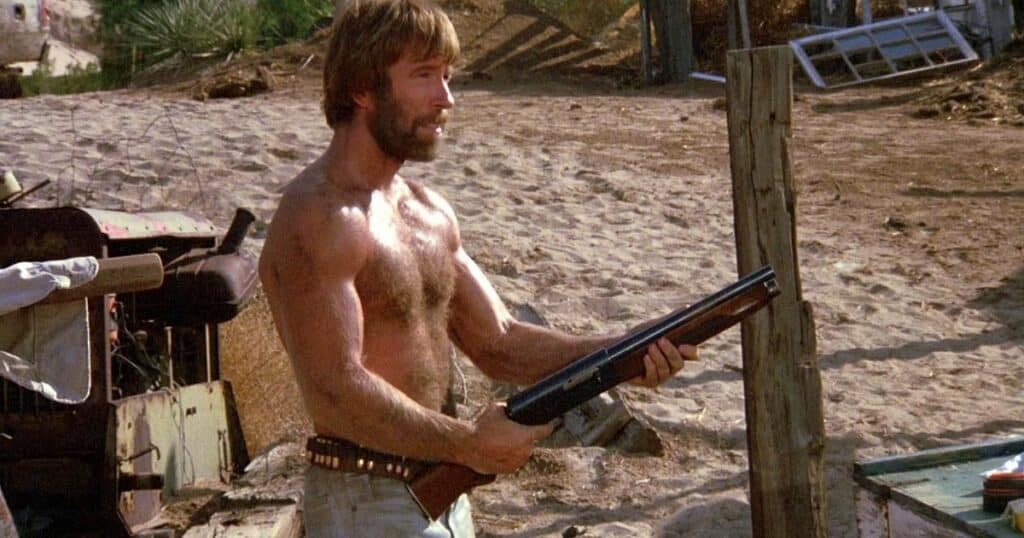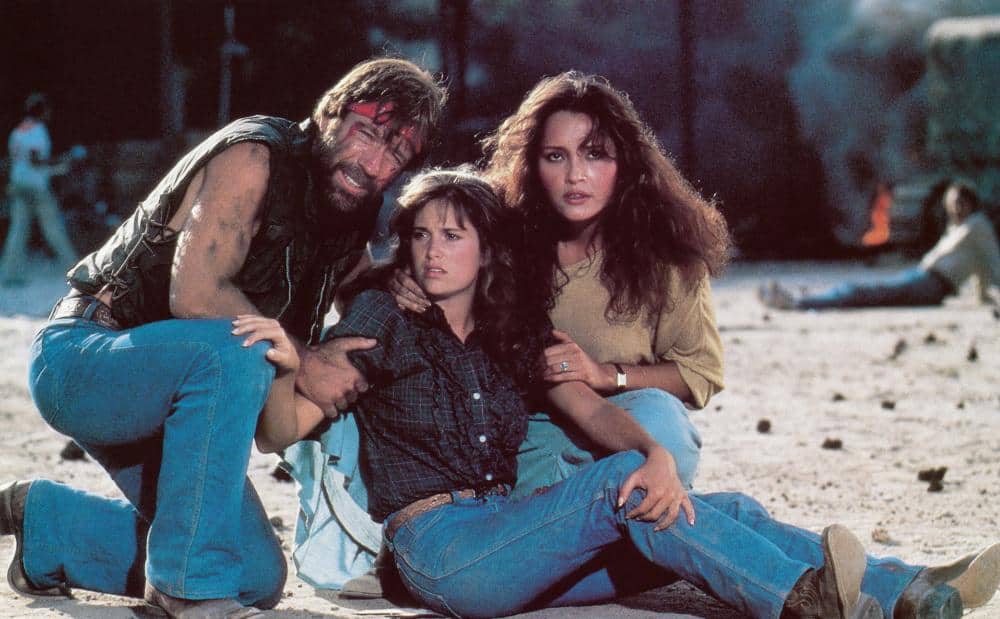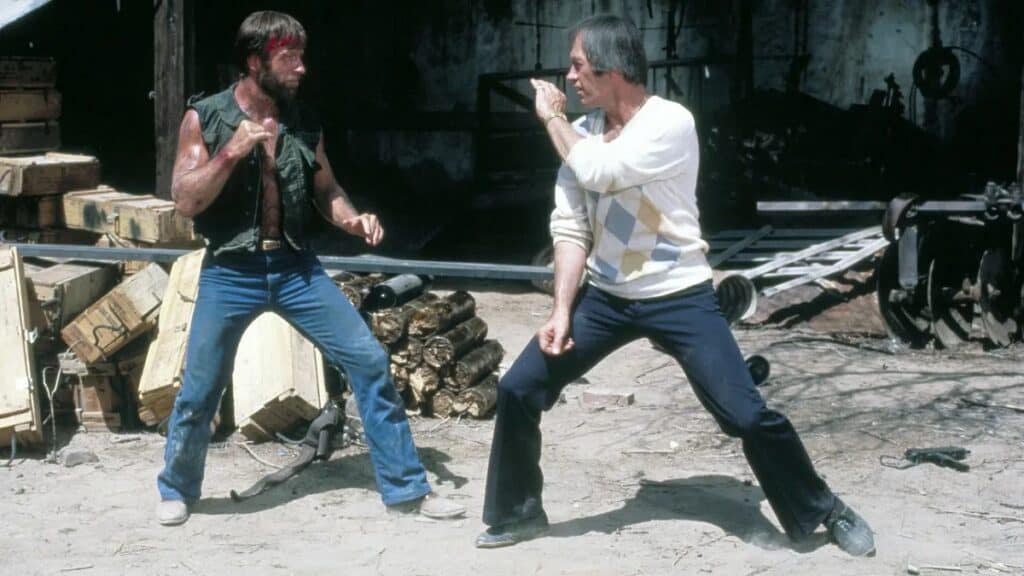This episode of Revisited was Written by Cody Hamman, Narrated by Travis Hopson, Edited by Juan Jimenez, Produced by Adam Walton and Chris Bumbray, and Executive Produced by Berge Garabedian.
INTRO: The eyes of the ranger are upon you… and while his name isn’t Walker, he is played by Chuck Norris. Ten years before he started playing a Texas Ranger on TV, Norris brought another Ranger to life in a feature film. His name was J.J. McQuade, and this martial arts practicing lawman brings down an international gun smuggler in an action-packed adventure released in 1983. Lone Wolf McQuade (watch it HERE) is celebrating its 40th anniversary this year – so it’s time for it to be Revisited.
SET-UP: Writer B.J. Nelson was inspired to write Lone Wolf McQuade after hearing about the life of a real-life Texas Ranger. A man who also had the nickname “Lone Wolf”: Manuel T. Gonzaullas. He had been a Ranger from 1920 to 1951. And in that time, he busted countless criminals while patrolling Texas oil towns. Gambling houses, slot machines, whiskey rings, and dope peddlers were not tolerated. And if any bad guys gave him grief, he was known to have an itchy trigger finger. Legend has it that he shot seventy-five criminals during his thirty-one years of service. But he said that number was grossly exaggerated. One of his most famous cases was the unsolved Phantom Killer case in Texarkana. Which inspired the 1976 film The Town That Dreaded Sundown, where the Gonzaullas character was renamed Morales and played by Ben Johnson. But even though Gonzaullas was his inspiration, Nelson’s story was entirely fictional. It just happened to center on another Texas Ranger who preferred to work alone. And is on his way to legendary status. J.J. McQuade.
Nelson envisioned the story as being a Spaghetti Western set in modern day. He even had Spaghetti Western star Clint Eastwood in mind while writing the title character. The El Paso-based McQuade is highly capable in the field. He can handle himself in a physical altercation or in a shootout. But his personal life is a disaster. His supercharged Dodge Ramcharger is coated in filth. His office is cluttered. His home, where he lives with his pet wolf, is such a mess that it’s referred to as a “piss house”. And his dedication to his job has ended his marriage. His ex and their teen daughter Sally still live in El Paso, but not with him. McQuade’s Captain acknowledges that his record of unassisted felony arrests is unrivaled. But he doesn’t like how McQuade conducts himself. The Captain’s idea of a Ranger is a model citizen. A clean-living, church-going, happily married pillar in the community. McQuade is seen as brutal, uncooperative, discriminatory, and obsolete. But then international gun smuggler Rawley Wilkes ambushes a military convoy, stealing weapons to sell to terrorists around the world… And McQuade is just the hero we need to bring him down. His Captain and the Feds try to warn him off the case. But when Sally gets mixed up in the situation, it becomes too personal for McQuade to set aside.

The script for Lone Wolf McQuade was brought to director Steve Carver by H. Kaye Dyal. Who also contributed ideas to the story. Carver instantly saw the appeal of making a Spaghetti Western-style ‘80s action movie. And when Eastwood passed on playing the title character, the director had a back-up option in mind. Martial artist turned actor Chuck Norris, who he had just worked with on the 1981 action film An Eye for an Eye. Norris had always said that his greatest inspiration was John Wayne, so why not let him star in his own Western? Problem was, the way McQuade was written made Norris hesitant to take on the role.
As Carver told The Flashback Files, “I said to Chuck, ‘This character is real seedy. We gotta get you more gruff and dirty. You gotta drink beer. You gotta have a beard.’ His first reaction was, ‘What about the kids? What are the kids gonna say?’ And I said, ‘The kids will love you. Don’t worry about it.’ He was very against drinking beer on screen and being dirty. I said, ‘But you’re a Texas Ranger. A lone wolf! You‘re not gonna be clean.’ It took a while for him to accept that, especially the beer. He didn’t want the kids to turn away. He wanted to be John Wayne. I said, ‘John Wayne was dirty in some of his pictures. Come on, now.’ We finally got him to accept. The beer thing turned out to be easy. Because he actually did drink beer.”
While getting the script in shape for production, Carver sought advice from his shooting buddy John Milius. Whose credits include Dirty Harry, Magnum Force, Apocalypse Now, Conan the Barbarian, and Red Dawn. Milius was able to help Carver solve some issues. Including coming up with the opening sequence, where McQuade takes on horse thieves who have captured some fellow lawmen. And the fact that McQuade is told to work with a less experienced officer, Deputy “Kayo” Ramos, is reminiscent of a situation in Dirty Harry.
With Norris in place as McQuade, Carver built the supporting cast around him. Robert Beltran was cast as Kayo, who McQuade comes to accept as a partner. Prolific character actor R.G. Armstong plays Captain Tyler, with another great character actor, L.Q. Jones, playing McQuade’s newly retired mentor Dakota. Leon Isaac Kennedy plays an FBI agent McQuade teams up with along the way. Turns out he’s not such a lone wolf after all. Barbara Carrera is McQuade’s potential love interest, Lola. A widow who tries to get him to clean up his act. And has an unfortunate connection to the villain. Daniel Frishman appears as Emilio Falcon, a boss in the Mexican Mafia. William Sanderson plays a reluctant informant called Snow. Sharon Farrell has a small role as McQuade’s ex. Dana Kimmell, best known for being the final girl in Friday the 13th Part III, plays their daughter Sally. Horror fans might also spot Jason Voorhees himself, Kane Hodder, as a henchman. And as bad guy Rawley Wilkes, we have David Carradine. Turning the climactic sequence into a showdown between Norris and the star of Kung Fu.

REVIEW: There’s a long list of incredible action movies that were released in the 1980s. Lone Wolf McQuade isn’t one you hear referenced often enough, as it deserves to be in the conversation as one of the best. We’re not saying it’s the best – but it’s up there. The movie makes for a really fun viewing experience from the moment it opens with a Spaghetti Western-inspired title sequence. Complete with a score composed by Francesco De Masi, doing his best to emulate Ennio Morricone.
At times, the film is completely ridiculous. Witness the first action scene in the movie, where McQuade finds himself holding an Uzi, surrounded by a dozen armed horse thieves. Some of the gang members are escaping on horseback, so who does he choose to shoot first? The guys escaping, of course. That’s okay, because the armed men around him just wait their turn to get shot, not one of them attempting to return fire. They obviously know what movie they’re in and are aware that it would be pointless to shoot at Chuck Norris. Moments of absurdity like that just add to the entertainment value. There are plenty more shootouts to come after that one. And ample opportunities for Norris to show off his fighting skills.
The star allowing himself to get dirtied up for this movie was a great decision. And not just because it resulted in him growing his iconic beard. McQuade’s filthy appearance, taste for beer, and his bad habits bring a lot of amusing moments into the movie. It’s funny to see how dirty and cluttered his home and office are. And it’s hilarious to see how annoyed he is when Lola shows up at his house and starts cleaning the place. He swipes the vitamins she has bought for him onto the floor. Dumps the fruit she placed in his refrigerator directly into the trash. And digs his beer back out of the trash.
As it turns out, beer for McQuade is the equivalent to spinach for Popeye. It enhances his strength. This is clearly demonstrated in what may be the most famous scene in the movie. Which also involves the character’s most prized possession, his truck, which can easily outrun other supercharged vehicles. After a failed assault on one of Wilkes’ bases, McQuade is captured and beaten to the edge of unconsciousness. He’s then placed inside his truck, which gets pushed into a pit that’s filled in with dirt. He has been buried alive… but luckily, there’s still a can of beer in the vehicle. He grabs the beer and pours it over his head, which gives him the strength to drive his super-supercharged truck right back up out of the ground.
McQuade may well be the best character Norris ever got to play. And Carver gave him a great group of co-stars to work with. Beltran and Kennedy make their characters likeable secondary heroes. Jones seems to be having a lot of fun playing Dakota. So does Frishman as Falcon. Friday the 13th fans will enjoy seeing Kimmell as McQuade’s repeatedly-endangered daughter. Armstrong is great as the stereotypical disapproving Captain. And Carrera has some nice scenes as the woman who is inexplicably drawn to McQuade. At first she tries to clean him up. Then she gives in and rolls around in the mud with him.
After McQuade and his sidekicks have laid waste to numerous henchmen, it’s time for the final showdown between the hero and Wilkes. Carradine gives a terrific villain performance throughout the film. Oozing charisma while also making it clear that Wilkes is a very dangerous man. The martial arts confrontation between him and Norris is the moment we’ve all been waiting for. And the actors did their best to make sure this fight would deliver the goods. They even both refused to have stunt doubles for the fight. This has stirred up rumors that the fight turned real, but that’s not the case. They both maintained their professionalism while filming the fight over the course of four days… and it was such a work-out, they could barely move by the end of those days.
Carradine told Psychotronic Video magazine, “We put our all into it. Chuck wanted us to do a fight that would be better than the one he’d done with Bruce Lee in The Way of the Dragon. And we were actually trying to go beyond that. I think we did, (although) photographically we didn’t. But as far as the fight was concerned, the combination of the two styles, you know, because I was very flowing and loose, and he was very solid and hard, I think we accomplished what we set out to do.”

LEGACY/NOW: Really, everyone involved with Lone Wolf McQuade accomplished what they set out to do. Because the Los Angeles Times reported that it made fifteen million dollars at the box office, three times its five million dollar budget. It was so successful, Norris credited it with allowing him to branch out from martial arts movies. After this, he was able to work on a wider variety of action movies. But, of course, he would still do some kicking and punching when the situation called for it.
Considering the type of movie that it is, the reviews weren’t too bad. It even managed to win over Roger Ebert, who gave it a rating of three and a half stars out of four. The critics who weren’t won over complained about the violence and abundance of action, but that’s the good stuff movie-goers were there to see in the first place.
The violence and action did nearly earn the film an R rating. Which is understandable, because the body count is quite high. A whole lot of people get shot. But Norris himself was successfully able to appeal to the MPAA ratings board. The PG-13 rating didn’t exist yet, it didn’t come about until 1984, so Norris was able to secure a PG rating for Lone Wolf McQuade. Speaking with the Philadelphia Inquirer, Norris explained that he got the MPAA to loosen up because of the strong, positive image he projects on the screen. And during his appeal, he again compared himself to John Wayne. He said, “My films are very similar to the John Wayne movies of the ’40s. He’d go in a bar and Jack Palance would pick a fight with him, and then Wayne would take out half the saloon. It’s the same theme: A man is pushed into a situation where he has to resort to violence.”
And as long as a man has been pushed into it, the violence merits a PG rather than an R.
Lone Wolf McQuade often gets overshadowed by its ‘80s action peers. But it’s a strong example of just how great action movies of the time could be. It’s a shame a sequel was never made, because McQuade is a character who deserved to go on a franchise worth of adventures. We never saw him again… but the movie did get a follow-up of sorts. The idea of playing a Texas Ranger stuck with Norris as the years went by. And a decade after McQuade was released, he decided to pitch a TV series that he would star in as a Texas Ranger. So it wouldn’t get bogged down in rights issues, it was decided his character would be named Walker rather than McQuade. But Lone Wolf McQuade director Steve Carver was involved in the early stages of development. He was going to direct some episodes of the show. Unfortunately, there was trouble behind the scenes. So Carver and his fellow McQuade producer Yoram Ben-Ami filed a lawsuit.
As Carver explained to The Flashback Files, “There were some producers that I was involved with, who took the idea of the Texas Ranger and the image of the Texas Ranger with Chuck. And we sued them. For 500 million dollars. MGM and CBS had bigger and better and more lawyers than we did, all the way to the Supreme Court. We failed to convince the Supreme Court that there were similarities. Now, you and I and anybody else knows that there are similarities between Lone Wolf McQuade and Walker, Texas Ranger. So, Chuck and I parted ways.”
Walker, Texas Ranger was another major success for Norris. Running for nine seasons and two hundred and three episodes. Plus a follow-up TV movie. The show was recently revived, with the title shortened to Walker and Jared Padalecki taking over the lead role. MGM and CBS were able to convince the courts that McQuade and Walker are entirely separate properties. But it does seem like we never would have gotten Walker if Norris hadn’t made McQuade first.
And whether or not you’re a Walker fan, it’s worth tracking down Lone Wolf McQuade. To watch a dirt-coated, beer-soaked Chuck Norris take down a charismatic David Carradine. It’s a bit Spaghetti Western. It’s very ‘80s. And it’s a whole lot of awesome.

